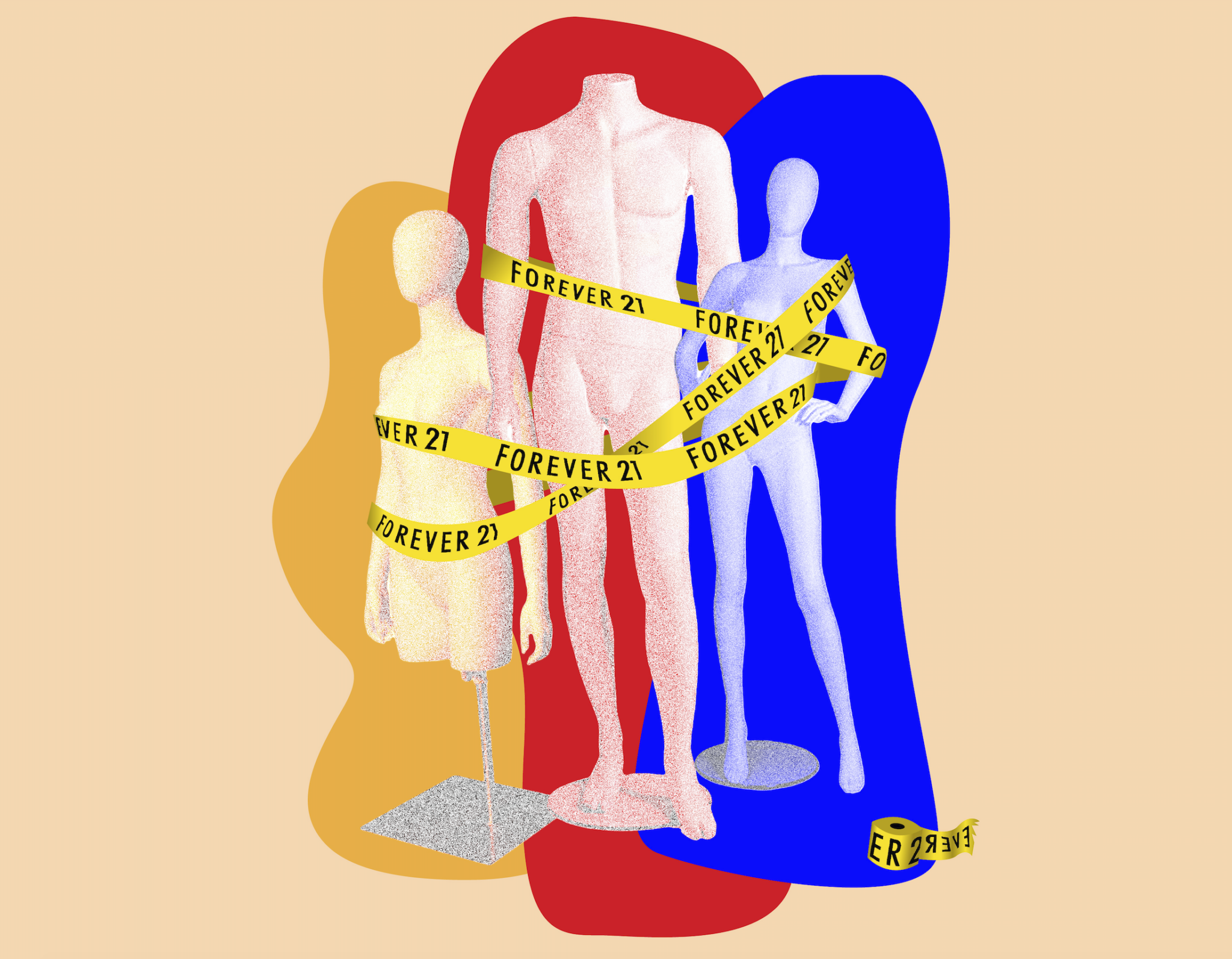Graphic Design By Brennan March
The early 2000’s were a time when malls were at their prime and fast fashion was becoming widely accessible; try and remember the excitement felt when Forever 21 first opened its doors in Canada in 2007. The trendy, low cost fashion store made its way into malls across the country, and rose to fame rather quickly, the affordability of clothes that were on trend was exciting, so Forever 21’s arrival in Canada was a powerful moment for young fashion consumers;they could look fashionable while having their clothes be affordable.
By the time Forever 21 made its Canadian debut, it was well established and thriving economically. The company was founded in 1984 in Los Angeles as a family business and quickly became a fashion chain. When they made the decision to expand the company from the United States into Canada in 2007, they did so at a large scale. The almost immediate success of the business gave owners Won Chang and Jin Sook Chang the confidence to continue to expand their chain at a quick pace. his confidence in Forever 21 was well deserved, as the owners made $700,000 after their first year of being in operation, and as they continued to expand the company across the United States their revenue expanded with it. While the brand developed, the stores became larger in size and the low prices at which the clothing was being produced was increasing.
From a business perspective what Forever 21 had done wrong was open such large stores at a quick pace. The company was confident in their fast fashion business model which based itself on quick turnaround designs at low prices. Their confidence was well earned, as the company grew exponentially since its debut quite quickly., After its introduction into Canada, sales lowered and instead of slowing production, they made even more. While continuing to increase production, the company also continued to open more physical spaces worldwide, even as their sales decreased.
At 16 years old I was hired at Forever 21 as a seasonal sales associate, and I continued to work there on and off up until this past November. My job at Forever 21 began two years after it had opened in my local mall. Given my time and experience with the company, I have gained a good insight into how the company operates in terms of management styles, shipment, and in-store policies; I’ve witnessed its highs and lows, as well as how the company treats the employees and stores first hand. The store made about $30,000 per day, sometimes more during its early days in the mall. Prior to the company’s official press release regarding its bankruptcy, they only made around $13,000 a day on average. Within this time frame, the company’s daily sales decreased more than 50%, yet the quantity of clothes being shipped to us on the daily had never changed in proportion to sales. In fact, the store received around 80 boxes of shipment every day during the week, excluding Saturday and Sunday; everyday new products were processed from shipment and placed on the floor as quickly as possible.
As the store’s sales decreased significantly, it would have made the most sense to slow down production and make things in lesser quantities. Yet, once the racks grew too full and the weekly sales dropped too low, the company implemented sales with ridiculous markdowns. Forever 21 made their clothing so cheap that it lived and died with the linear fashion cycle; a system in which the clothes begin with production and ends with disposal. Although the in-store clothes were kept for as long as possible on the sales floor, these clothes were ultimately being designed for landfills. Spending money to produce clothing at such a high rate just to be put on a 20% sale the following week turned little to no profit and kept the store at full capacity.
When the official statement declaring the Forever 21 bankruptcy was issued, many employees were not surprised. All employees received a letter from in-store management, accompanied by an information package in the mail from the company’s lawyers. The letters were pages long, and made it very clear that no financial compensation would be granted to any of the employees when the stores ended up closing. Personally, the lack of financial compensation didn’t upset me; if anything, this was expected. It did not come as a shock because the company had frequently used low cost as a strategy.
This pattern of frugality becomes even more apparent when considering Forever 21’s return policy, or lack thereof; only offering exchanges or store credit ensured that the stores would make some sort of profit. Exchanges were usually damaged, and were discounted by a miniscule amount and then resold, and damaged items often ranged from rips, broken accessories and even clothes with visible wear.
As for the employees, Forever 21 cuts costs even more by ignoring backroom safety regulations to save money, and providing their employees with a whopping 10% employee discount on regular priced items, the company always attempted to save money doing the wrong things. Considering the amount of work sales associates performed that was outside of their job descriptions, they were grossly underpaid. While working at the store, my colleagues and I stayed as late as 1AM to close the store without financial compensation such as overtime. Getting paid minimum wage is typical in retail settings, however after asking around most employees of Forever 21’s competing retailers do substantially less work and have a much clearer job description. Managers, who are responsible for the sales associates and the store’s daily operations, werepaid only $2 more than associates with little benefits.
Perhaps their biggest mistake from a business perspective was not being able to keep up with the ever changing consumer trends. With things like sustainability and ethics become increasingly important, the fast fashion retailer simply didn’t oblige. Similar stores like H&M have altered their marketing strategies, as well as stopped all further expansion within Canada to allow themselves to obtain the profits they need to survive. Through their emphasis on sustainable fashion, H&M has been able to survive retails current wave of changes by maintaining consumer interest.
In order for the company to bounce back from its bankruptcy, it needs to rebrand itself to become the brand that once captivated the hearts of 14-20 something year olds in the early 2000s; they need to become aware as to what matters most to consumers today.
From my experience with working for Forever 21, I have observed that they need to better decide where their money should be spent. The company needs to both prioritize maintaining profits while also making customers and entry level employees content. What Forever 21 has given me is perspective onto the world of fast fashion and retail, and how over time a brand can quickly become relevant for all of the wrong reasons. The company is remaining its stores in the United States with hopes to regain the reputation it once had, although during a time where transparency within companies is key, they need to rethink the entire business strategy and branding as a whole.
























